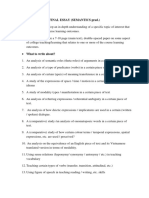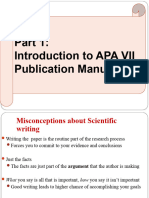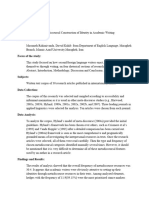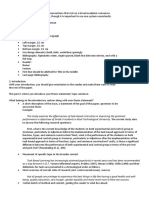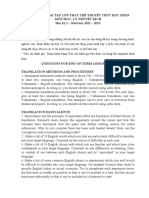ESP2 Evaluation Sheet: Criteria Number of Pages Score /1 /2
ESP2 Evaluation Sheet: Criteria Number of Pages Score /1 /2
Uploaded by
Logi CheminotCopyright:
Available Formats
ESP2 Evaluation Sheet: Criteria Number of Pages Score /1 /2
ESP2 Evaluation Sheet: Criteria Number of Pages Score /1 /2
Uploaded by
Logi CheminotOriginal Description:
Original Title
Copyright
Available Formats
Share this document
Did you find this document useful?
Is this content inappropriate?
Copyright:
Available Formats
ESP2 Evaluation Sheet: Criteria Number of Pages Score /1 /2
ESP2 Evaluation Sheet: Criteria Number of Pages Score /1 /2
Uploaded by
Logi CheminotCopyright:
Available Formats
ESP2 Evaluation Sheet
Criteria Number of Pages Score
Abstract One-paragraph summary of the project 1 paragraph /1
Introduction Problem statement is clearly stated 2 to 4 pages /2
Research question is clearly stated
Significance is clearly stated
Review of the Background information is clearly 10 to 14 pages /5
Literature presented
Review displays knowledge of the field
Review is well-organized
More than 10 studies have been cited
Data and Excellent choice of population 1 to 2 pages /2
Methodology Sample size is appropriate
Excellent choice of instrument
Design and procedures are clearly laid
out
Findings Analysis and discussion are coherent 10 to 14 pages /6
reflect understanding of subject matter
Demonstrate understanding of theoretical
concepts
Reflect mature, critical thinking skills
Conclusion Results are discussed in terms of 2 to 4 pages /2
previous research
Major ideas are summarized
Recommendations for action are
provided
References Provides a list of sources in alphabetical /1
order
Appendices A sample of the research instrument(s) /1
is/are appended
Quality of The project follows the principles of Plagiarism will /20
Writing academic writing result in a failing
Thoroughly follows a consistent style: grade.
Times New Roman, size 12, double-spaced
Few grammatical or spelling errors Plagiarism is using
Organization is excellent others’ words or ideas
Sources are cited in-text and a list of without citing the
references is added at the end source.
Manuscript length is between 30 and 40
pages (excluding front and back matter) To avoid plagiarism,
paraphrase and
summarize and use
direct quotes
sparingly.
Total /40
Sample Reference List Formatted in APA Style
References
Alibali, M. & Don, L. (2001). Children’s gestures are meant to be seen. Gesture, 1(2), 113-127.
Alibali, M., & Goldin-Meadow, S. (1993). Gesture-speech mismatch and mechanisms of learning: What the
hands reveal about a child's state of mind. Cognitive Psychology, 25 (4), 468-523.
Bates, J. (1975). The communicative hand. In J. Benthall & T. Polhemus (Eds.), The body as a medium of
expression (pp. 175-194). London: Allen Lane Penguin Books.
Gullberg, M. (1998). Gesture as a communication strategy in second language discourse. Sweden: Lund
University Press.
Gumperz, J. J. (1982). Discourse strategies. Cambridge: Cambridge University Press.
Harms, W. (2000). Gestures add valuable information to teachers’ math lessons. University of Chicago
Chronicle, 19 (11), 1-2. Retrieved on 11/6/2008 from: http://chronicle.uchicago.edu/000302/
gesture.html.
Heath, C. (1992). Gesture’s discrete tasks: Multiple relevances in the contextualization of language. In P.
Auer & A. di Luzio (Eds.), The Contextualization of language (pp. 102-127). Amsterdam and
Philadelphia: John Benjamins.
Jungheim, N. (1995). Assessing nonverbal ability as a component of language learners' communicative
competence. Doctoral Dissertation. Temple University.
Kita, S. (1993). Japanese adults’ development of English speaking ability: Change in the language-thought
process observed through spontaneous gesture. Paper presented at the Second Language
Research Forum. University of Pittsburgh.
Kita, S. (2000). How representational gestures help speaking. In D. McNeill (Ed.), Language and gesture
(pp.162-185). Cambridge, England: Cambridge University Press.
McNeil, D. (2002). Triangulating the growth point—arriving at consciousness. In L. S. Messing & R. Campbell
(Eds.), Gesture, speech, and sign (pp. 77-92). Oxford: Oxford University Press.
Schegloff, E. (1992a). Repair after next turn: The last structurally provided defense of intersubjectivity in
conversation. American Journal of Sociology, 97 (5), 1295-1345.
Schegloff, E. (1992b). To Searle on conversation: A note in return. In J. R. Searle et al., (On) Searle on
conversation (pp.113-128). Amsterdam and Philadelphia: John Benjamins.
Scollon, R., & Scollon, S. W. (1995). Intercultural communication: A discourse approach (2nd ed.). Cambridge,
MA: Blackwell.
The New oxford dictionary of English. (2008). Oxford University Press: Oxford.
Vygotsky, L. S. (1987 [1945]). Thought and language. Cambridge, MA: MIT Press.
You might also like
- APA 7th Edition PDFDocument25 pagesAPA 7th Edition PDFTalent Tonderai Zuze100% (10)
- Template For The Cambridge DELTA LSA Background Essay and Lesson PlanDocument7 pagesTemplate For The Cambridge DELTA LSA Background Essay and Lesson Planmcgwart80% (10)
- Microsoft Word - SyllabusDocument28 pagesMicrosoft Word - SyllabusHamza Mumtaz0% (1)
- English Semantic: Semantic Relation Among WordsDocument19 pagesEnglish Semantic: Semantic Relation Among WordsLogi Cheminot100% (1)
- PDFDocument30 pagesPDFLogi CheminotNo ratings yet
- Essential AgreementsDocument6 pagesEssential Agreementsapi-250227854No ratings yet
- Proposal Evaluation SheetDocument2 pagesProposal Evaluation SheetLogi CheminotNo ratings yet
- AW4002 Lecture10 2011Document21 pagesAW4002 Lecture10 2011AJ TabuenaNo ratings yet
- The Title Consists of 12 Up To 15 Words, Must Be To The Point. Times New Roman (TNR), Bold, 14 PTDocument2 pagesThe Title Consists of 12 Up To 15 Words, Must Be To The Point. Times New Roman (TNR), Bold, 14 PTAgri Teguh wibowoNo ratings yet
- AEG114 Final Assignment Brief - SU21P1Document4 pagesAEG114 Final Assignment Brief - SU21P1Huỳnh Lê Mỹ Huyền (FGW HCM)No ratings yet
- Verbs Used in Literature ReviewDocument8 pagesVerbs Used in Literature Reviewafmztsqbdnusia100% (1)
- Week 5 - APADocument31 pagesWeek 5 - APAantoshkachanelNo ratings yet
- 2013student Course Info - TSL 712Document7 pages2013student Course Info - TSL 712Hazim HasbullahNo ratings yet
- AEG114 Final Assignment Brief - Fa22P1 GBS1005BDocument4 pagesAEG114 Final Assignment Brief - Fa22P1 GBS1005BTran Hung Minh (FGW HCM)No ratings yet
- 5 Activities Book Review or Article CritiqueDocument3 pages5 Activities Book Review or Article CritiqueheydaphnieNo ratings yet
- Topics For Final EssayDocument3 pagesTopics For Final EssayNgânNo ratings yet
- Basics of APA 7Document37 pagesBasics of APA 7aaminah mumtazNo ratings yet
- Writing Up Your Research Proposal Tips POLS7229 - HMDocument10 pagesWriting Up Your Research Proposal Tips POLS7229 - HMSon NguyenNo ratings yet
- GUIDELINES For Author (EDIT)Document2 pagesGUIDELINES For Author (EDIT)fredyNo ratings yet
- APC312 April 2012 Assessment & Marking CriteriaDocument2 pagesAPC312 April 2012 Assessment & Marking Criteriahi_monestyNo ratings yet
- BMP3004+WW As1+Brief Sep+2022+CohortDocument5 pagesBMP3004+WW As1+Brief Sep+2022+CohortSwarnali Dutta ChatterjeeNo ratings yet
- Tfa Embedded Assessment 2 RevisedDocument2 pagesTfa Embedded Assessment 2 Revisedapi-261693192No ratings yet
- Draft Paper AppLing1Document5 pagesDraft Paper AppLing1luffyaho20No ratings yet
- Discourse AnalysisDocument8 pagesDiscourse Analysiskaifi ChaudharyNo ratings yet
- BMP3001 April24 As1Document5 pagesBMP3001 April24 As1Elena SeverinNo ratings yet
- Report Writing 2018Document25 pagesReport Writing 2018Daren MansfieldNo ratings yet
- Literature Review VerbsDocument6 pagesLiterature Review Verbsafmzfxfaalkjcj100% (1)
- Research FormatDocument10 pagesResearch FormatLea Pearl Imbang Francisco IINo ratings yet
- Success Criteria Research PaperDocument1 pageSuccess Criteria Research Paperapi-395504895No ratings yet
- Thompson Pacing Guide Grade/Course English 8 Grading PeriodDocument13 pagesThompson Pacing Guide Grade/Course English 8 Grading Periodapi-233202466No ratings yet
- ENGL 1302 Research PacketDocument43 pagesENGL 1302 Research PacketjohnNo ratings yet
- Journal Review 7Document3 pagesJournal Review 7Jisriatul BaniahNo ratings yet
- BBR Training On LR 7 Sept 2019Document20 pagesBBR Training On LR 7 Sept 2019mahfuja miliNo ratings yet
- MGT 201 Business EnglishDocument6 pagesMGT 201 Business EnglishBenford SmithNo ratings yet
- DLL ENGLISH 8 Sept. 11-15Document3 pagesDLL ENGLISH 8 Sept. 11-15Erold TarvinaNo ratings yet
- 2022 语用proposal 模板Document2 pages2022 语用proposal 模板vicktoriya.beletskayaNo ratings yet
- COMPREHENSIVE GUIDEBOOK FOR TEACHERS AND STUDENTS On PRACTICAL RESEARCH AND CAPSTONE PAPER DEVELOPMENTDocument55 pagesCOMPREHENSIVE GUIDEBOOK FOR TEACHERS AND STUDENTS On PRACTICAL RESEARCH AND CAPSTONE PAPER DEVELOPMENTmoscajomari05No ratings yet
- The Twits S2Document19 pagesThe Twits S2S TANCREDNo ratings yet
- Rubrics and Guidelines For Research Proposal and Oral PresentationDocument4 pagesRubrics and Guidelines For Research Proposal and Oral PresentationGail Althea100% (1)
- Panduan Bagi Penulis Untuk Mempersiapkan Jurnal Eduma Menuju Jurnal Pendidikan Matematika Berstandar InternasionalDocument4 pagesPanduan Bagi Penulis Untuk Mempersiapkan Jurnal Eduma Menuju Jurnal Pendidikan Matematika Berstandar InternasionalAkperNo ratings yet
- Teaching EnglishDocument7 pagesTeaching EnglishS.ParamNo ratings yet
- References Proper CitationDocument32 pagesReferences Proper CitationPatrick SolomonNo ratings yet
- RW 11 12 Unit 1 Lesson 4 Academic DiscourseDocument23 pagesRW 11 12 Unit 1 Lesson 4 Academic DiscourseMichael CortezNo ratings yet
- Guidelines in Writing Chapter 1Document59 pagesGuidelines in Writing Chapter 1Ian RodriguezNo ratings yet
- Study Guide ConradDocument2 pagesStudy Guide ConradReemNo ratings yet
- How To Write A Term PaperDocument4 pagesHow To Write A Term PaperAlt COCNo ratings yet
- Quarter 3-Efapp 12-ReviewerDocument8 pagesQuarter 3-Efapp 12-ReviewerRoden FernandezNo ratings yet
- Ling 414 Project DescriptionDocument7 pagesLing 414 Project Descriptionmusic relaxNo ratings yet
- Individual Coursework Portfolio Module Code: Module Title: SessionDocument17 pagesIndividual Coursework Portfolio Module Code: Module Title: SessionFadele Ayotunde AlabaNo ratings yet
- Hirvela - Why Am I Paraphrasing Undergraduate ESL Writers' Engagement With Source-Based Academic Writing and ReadingDocument12 pagesHirvela - Why Am I Paraphrasing Undergraduate ESL Writers' Engagement With Source-Based Academic Writing and ReadingdooblahNo ratings yet
- Outline Error Analysis New 2024Document6 pagesOutline Error Analysis New 2024Aisyah PrimaaNo ratings yet
- Sanjay Jain DMCR ACA-401D DEF2 REV1Document3 pagesSanjay Jain DMCR ACA-401D DEF2 REV1Sanjay JainNo ratings yet
- Reporting Verbs in Literature ReviewDocument7 pagesReporting Verbs in Literature Reviewafmztsqbdnusia100% (1)
- Year 2 English Portfolio AboveDocument0 pagesYear 2 English Portfolio AboveernsteinsNo ratings yet
- TemplateDocument10 pagesTemplatesisca fujiNo ratings yet
- HƯỚNG DẪN BÀI TẬP LỚN THAY THẾ THI KẾT THÚC HỌC PHẦNDocument9 pagesHƯỚNG DẪN BÀI TẬP LỚN THAY THẾ THI KẾT THÚC HỌC PHẦNKb NguyenNo ratings yet
- Template JPP (Inggris)Document3 pagesTemplate JPP (Inggris)tutorotomotifNo ratings yet
- Writing The Literature Review: Kim LieDocument4 pagesWriting The Literature Review: Kim LieMohamed YusefNo ratings yet
- IDBS.. Literature ReviewDocument28 pagesIDBS.. Literature ReviewMajor Robson GabaNo ratings yet
- Research Author GuideDocument67 pagesResearch Author GuideR&D Cell IIMT College Greater NoidaNo ratings yet
- IM - Final Assignment 2024Document5 pagesIM - Final Assignment 2024Thanh MaiNo ratings yet
- Regents Exams and Answers: English Revised EditionFrom EverandRegents Exams and Answers: English Revised EditionNo ratings yet
- Applied Linguistics: A Genre Analysis Of: Research Articles Results and Discussion Sections in Journals Published in Applied LinguisticsFrom EverandApplied Linguistics: A Genre Analysis Of: Research Articles Results and Discussion Sections in Journals Published in Applied LinguisticsNo ratings yet
- Sitepoint - Build Your Own Wicked WordPress Themes (Aug 2010)Document2 pagesSitepoint - Build Your Own Wicked WordPress Themes (Aug 2010)Logi CheminotNo ratings yet
- Semantic Relations - StudentsDocument4 pagesSemantic Relations - StudentsLogi CheminotNo ratings yet
- Comma Splice and Run-On SentenceDocument5 pagesComma Splice and Run-On SentenceLogi CheminotNo ratings yet
- GrammarDocument14 pagesGrammarLogi CheminotNo ratings yet
- Lesson 06 The Cooperative Principle PDFDocument27 pagesLesson 06 The Cooperative Principle PDFLogi CheminotNo ratings yet
- The Time Saving Copy/Paste Wordpress Cheat Sheet: Basic Template Files Header Functions Navigation MenuDocument2 pagesThe Time Saving Copy/Paste Wordpress Cheat Sheet: Basic Template Files Header Functions Navigation MenuLogi CheminotNo ratings yet
- Sciencedirect: Difficulties of Learning Arabic For Non-Native SpeakersDocument8 pagesSciencedirect: Difficulties of Learning Arabic For Non-Native SpeakersLogi CheminotNo ratings yet
- The Prague SchoolDocument1 pageThe Prague SchoolLogi CheminotNo ratings yet
- Lessons 1 17: MODULO 2 - 2008-9 Meaning and Discourse in EnglishDocument35 pagesLessons 1 17: MODULO 2 - 2008-9 Meaning and Discourse in EnglishLogi CheminotNo ratings yet
- Socio LinguisticDocument22 pagesSocio LinguisticLogi CheminotNo ratings yet
- Communities, Networks, and IndividualsDocument8 pagesCommunities, Networks, and IndividualsLogi CheminotNo ratings yet
- Research Proposal Template 05Document2 pagesResearch Proposal Template 05Logi CheminotNo ratings yet
- Research Proposal Template 13Document2 pagesResearch Proposal Template 13Logi Cheminot100% (1)
- Universal GrammarDocument9 pagesUniversal GrammarLogi CheminotNo ratings yet
- Deep and Surface Structure and AmbiguityDocument11 pagesDeep and Surface Structure and AmbiguityLogi CheminotNo ratings yet
- Module 1: Personal Development Learner's HandbookDocument22 pagesModule 1: Personal Development Learner's HandbookAlwina Jarabejo100% (1)
- SJV Fee Structure - 24Document11 pagesSJV Fee Structure - 24RaazNo ratings yet
- DLL MTB-3 Q2 W8Document4 pagesDLL MTB-3 Q2 W8Carla Gomez - EspantoNo ratings yet
- Progress Report For Ehsaas Updated 15 Dec 2020 1Document1 pageProgress Report For Ehsaas Updated 15 Dec 2020 1M Ramzan M RamzanNo ratings yet
- Final Test Task For LLLP 2020 by HasnaDocument3 pagesFinal Test Task For LLLP 2020 by HasnaHASNANo ratings yet
- Research Proposal 2Document11 pagesResearch Proposal 2hfjnbbwmyfNo ratings yet
- Certificate of Registration: Palawan State UniversityDocument1 pageCertificate of Registration: Palawan State UniversityFayebie ToledoNo ratings yet
- DLL 7Document2 pagesDLL 7elynNo ratings yet
- 5e Lesson Plan Quadratic Exploration Individual ProjectDocument4 pages5e Lesson Plan Quadratic Exploration Individual Projectapi-474068432No ratings yet
- SOCIAL WORK Services, Processes, and MethodsDocument25 pagesSOCIAL WORK Services, Processes, and MethodsIan Jay MacaraegNo ratings yet
- Grades 6 CotDocument15 pagesGrades 6 CotIRENE REFORMANo ratings yet
- Frontloading StrategyDocument2 pagesFrontloading Strategyapi-312958652100% (1)
- Sayap Ilmu Cooperation Proposal-1 PDFDocument10 pagesSayap Ilmu Cooperation Proposal-1 PDFsairamNo ratings yet
- Government of Tamil Nadu: Teachers Recruitment BoardDocument2 pagesGovernment of Tamil Nadu: Teachers Recruitment BoardkvijayasokNo ratings yet
- Download full (eBook PDF) Understanding Social Problems 5th Canadian Edition ebook all chaptersDocument45 pagesDownload full (eBook PDF) Understanding Social Problems 5th Canadian Edition ebook all chaptersfudjoebexico100% (1)
- AICTE Report 3Document6 pagesAICTE Report 3VIKRAMNo ratings yet
- Reading Text CriticallyDocument15 pagesReading Text CriticallyAvianna HeraNo ratings yet
- History of Education EssayDocument2 pagesHistory of Education Essayapi-704337916No ratings yet
- Case StudiesDocument104 pagesCase StudiesIshanNo ratings yet
- Quarter 2 - Week 2: Learning Activity SheetDocument13 pagesQuarter 2 - Week 2: Learning Activity Sheetedz50% (2)
- Gr1 Vol1 Math QPDocument7 pagesGr1 Vol1 Math QPSmartkidz International PreschoolNo ratings yet
- 4 A Lesson PlanDocument3 pages4 A Lesson Plannancy seseNo ratings yet
- Induction Training Schedule 22-02-2024Document3 pagesInduction Training Schedule 22-02-2024raheelaNo ratings yet
- Explicit Instruction Lesson Plan FormatDocument2 pagesExplicit Instruction Lesson Plan Formatapi-301194112No ratings yet
- Designation of Contract ICTDocument2 pagesDesignation of Contract ICTTupsan Nhs Mambajao CamiguinNo ratings yet
- Dental Materials DDMDocument8 pagesDental Materials DDMDarwin Diampo J. LimNo ratings yet
- Essay On ESPDocument2 pagesEssay On ESPorianassz1No ratings yet
- 21ST Century SkillsDocument7 pages21ST Century Skillssaf moNo ratings yet
- Study of The Importance of Grammer in LearningDocument42 pagesStudy of The Importance of Grammer in LearningAbdul HaqNo ratings yet















